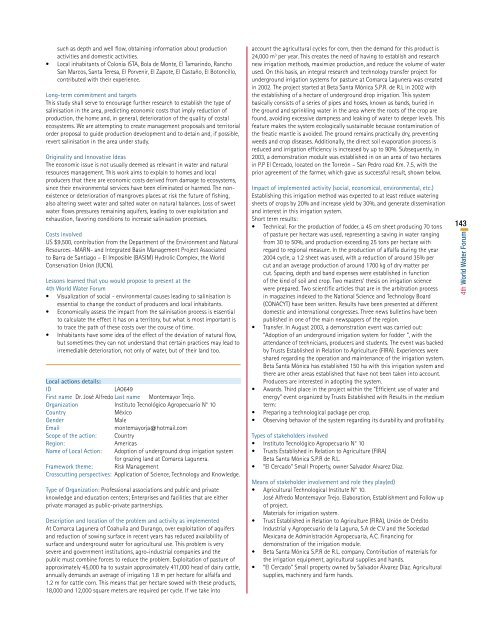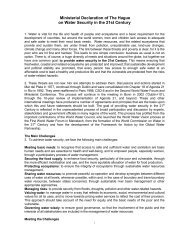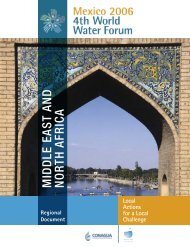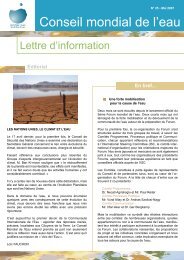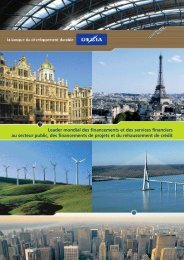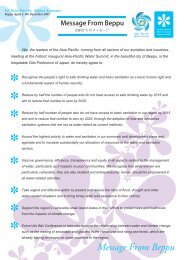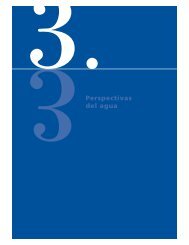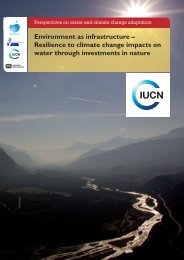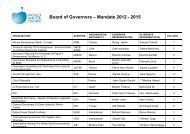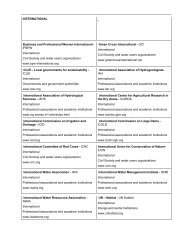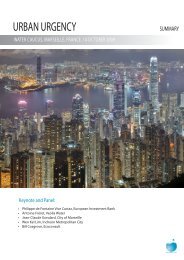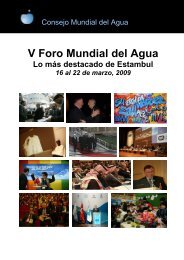1424th <strong>World</strong> <strong>Water</strong> Forumagricultural areas of the State. Meetings have been held with technicians,producers, packers, with producers of horticultural products and federal,state and municipal authorities in relation to the availability of containerswhich contain pesticide. Agreements have been made with industry and theauthorities to collect and eliminate containers which formerly had pesticides,and with the AMIFAC (Asociación Mexicana de la Industria Fitosanitaria,A.C.), to pick up all processed material and disposed of it at recycling sites orfinal confinement areas, engage constructor services to build or conditioncollection centers under required specifications, also giving training courses onthe handling, treatment, and classification of containers which formerly hadpesticides.Originality and Innovative IdeasThe establishment of an Empty Pesticide Container Recollection Center isconsidered as innovative for the State of Sonora, as although other statesin the republic have these facilities, Sonora did not have any center for thedisposal of such containers, not withstanding the large number of farmersoperating who generate this waste. The technology employed in the projectis very simple, as it only requires a press to more easily handle and transferempty containers.Costs involvedFor the installation of the collection center an approximate amount of$890,352.00 is required, including conditioning and/or construction expenses,electric power, press, strapping machine and operating personnel.Lessons learned that you would propose to present at the4th <strong>World</strong> <strong>Water</strong> ForumEstablishing a center to temporarily store empty pesticide containers andsubsequently recycle them or use them as alternative fuel; not only reducingenvironmental contamination risks, as well as risks to workers’ health, butalso by reusing plastic in a safe manner, there is the opportunity of reducingexploitation of additional sources that may break the environmental balanceand affect other areas of Mexico. On the other hand, from the point of viewof current marketing schemes of food products, quality assurance programsare set up that involve the proper use and handling of pesticides. This makesit a demand of consumers who require a harmless product with high qualitystandards, an available implementing system and complying with requirementsfor proving that harmless foods are produced.Local actions details:IDLA1397First name Ana Cecilia Last name Carranza ChotoOrganizationMinisterio de Medio Ambiente y RecursosNaturalesCountryEl SalvadorGenderFemaleEmailccarranza@marn.gob.svScope of the action: BasinRegion:<strong>Americas</strong>Name of Local Action: Economic impact of underground watersalinisation in production and domestic activitiesat in the coastal zone in the lower basin of the PazRiver, El SalvadorFramework theme: Risk ManagementCrosscutting perspectives: Application of Science, Technology and Knowledge.Type of Organization: National and local governments, authorities andassociated; International and intergovernmentalinstitutions– farming (extensive green areas, cotton, sugar cane and banana) have hadan important impact on the territorial transformation of the costal plain.Soil use shows that 10.2% of the basin is used properly, 51.9% of the areais used inappropriately, given limits of land use category, or is over used. Forsome years now, inhabitants have started to voice the difficulties of usingwater from wells for different purposes (home, farming and irrigation) severalmonths a year. They complain because the water is salty. In a quick surveyperformed at the zone’s wells, it was evident that they have suffered slight,moderate and even severe salinisation (solids dissolved in suspension andelectric conductivity). Inappropriate use of soils has affected ecosystemsand agro systems on the coast, but it is believed that its dynamics is not themain cause of change on costal aquifers in terms of its effect on salinisationprocess. It is believed that there are other more direct causes on this process,including the most important, that is the change of the flow of the Paz River,as perceived by the area’s inhabitants. On the other hand, it is known thatcoastal aquifers are very vulnerable to contamination, due to lixiviation ofagricultural or organic products deposited on the surface, but also in theface of salt intrusion processes, resulting in the imbalance between saltycomponents and sweet water. This allows the area of contact to transfer toareas where sweet water used to be contaminating the aquifer. In addition toecologic consequences and damage to ecosystems (which may be irreversible),there is the effect on production activities and home economies as sweetwater may no longer be used for agriculture and home use.Impact of implemented activity (social, economical, environmental, etc.)The limit of availability and water quality for consumption and productionhas resulted in over exploitation of the aquifer (use of diesel pumps and toolsto extract the largest amount of water from greater depths and openingnew wells). The effect of salinisation is particularly felt by inhabitants of thecostal area of the San Franciso Menéndez Municipality between El Zapote andBola de Monte. Reduction in terms of gross production has been acute. theeffect of which is not only a of the amounts produced, but also inhabitantshave been obliged to change from less profitable activities to new activities;from agriculture to fishing, in such away that now there are many morefishermen. This could not be so serious if fishing had not diminished with thereproduction sites being eliminated (mangrove swamps at Garita Palmera andEl Botoncillo). Some results showed that in terms of the loss of productionactivities in some homes, income from fishing has dropped to 50% accordingto local inhabitants. Furthermore, hardship (and risk) has increased in fishingby having to go farther, thus increasing operating costs. Also agricultural andcattle activities have suffered an increase in production costs, since investmenthas been required in the irrigation system, fuels and fertilizers, in comparisonwith production 20 year ago. The situation in homes is no less difficult, sinceevery family at least has one well on their property and most (85.7%) dependon the costal aquifer for the supply of water to these wells. A total of 28families have 52 wells and a high percentage (53.6%) uses pumps. Talking withfamily groups it was ascertained that they suffer supply problems during dryseasons (November – May) and 53.6% have water quality problems affectedby salinity, in some events even odors and turbidity. However, only a little morethan third buy water from private distributors and this water is used solelyfor co<strong>ok</strong>ing and drinking. The price of water is on average $0.01 per liter. Thiswater is distributed by private marketers in barrels on back of loading trucks.Only on one occasion was water chlorination control was seen in the Barra deSantiago community and its concentration was much higher than acceptablelevels.Types of stakeholders involved• Department of the Environment and National Resources, MERN.• Integrated Basins Management Project Associated to Barra de SantiagoHydrolic Complex – El Imposible (BASIM).• <strong>World</strong> Union in Favor of Nature (UICN)Description and location of the problem and activity as implementedThe Paz River basin is located in the south west of the country, has anapproximate area of 261,799.2 hectares, 65.4% of it belongs to the Republicof Guatemala (171,054.7 ha) and 34.6% (90,744.5 ha) to the Republic of ElSalvador. This makes this basin one of the most important bi-national basinsin the region. In the last 50 years, the Paz River basin on the Salvadorian sidehas been affected in various ways: extreme climates events (tropical stormstore away mangrove on some areas –Garita Palmera and El Botoncillo- alteringexisting salinity levels. Recent trends in the international market of agricultureMeans of stakeholder involvement and role they play(ed)• The Department of the Environment and Natural Resources providedintegrated management guidelines in relation to ecosystems, andit supports initiatives for fostering economic assessment of naturalresources.• The Integrated Basin Management Project Associated to Barra de Santiago– El Imposible Hydrolic Comples (BASIM), the <strong>World</strong> ConservationUnion (UICN), facilitates means to perform activities for compiling andsystemizing information about salinisation indexes and other parameters,
such as depth and well flow, obtaining information about productionactivities and domestic activities.• Local inhabitants of Colonia ISTA, Bola de Monte, El Tamarindo, RanchoSan Marcos, Santa Teresa, El Porvenir, El Zapote, El Castaño, El Botoncillo,contributed with their experience.Long-term commitment and targetsThis study shall serve to encourage further research to establish the type ofsalinisation in the area, predicting economic costs that imply reduction ofproduction, the home and, in general, deterioration of the quality of costalecosystems. We are attempting to create management proposals and territorialorder proposal to guide production development and to detain and, if possible,revert salinisation in the area under study.Originality and Innovative IdeasThe economic issue is not usually deemed as relevant in water and naturalresources management. This work aims to explain to homes and localproducers that there are economic costs derived from damage to ecosystems,since their environmental services have been eliminated or harmed. The nonexistenceor deterioration of mangroves places at risk the future of fishing,also altering sweet water and salted water on natural balances. Loss of sweetwater flows pressures remaining aquifers, leading to over exploitation andexhaustion, favoring conditions to increase salinisation processes.Costs involvedUS $9,500, contribution from the Department of the Environment and NaturalResources -MARN- and Integrated Basin Management Project Associatedto Barra de Santiago – El Imposible (BASIM) Hydrolic Complex, the <strong>World</strong>Conservation Union (IUCN).Lessons learned that you would propose to present at the4th <strong>World</strong> <strong>Water</strong> Forum• Visualization of social - environmental causes leading to salinisation isessential to change the conduct of producers and local inhabitants.• Economically assess the impact from the salinisation process is essentialto calculate the effect it has on a territory, but what is most important isto trace the path of these costs over the course of time.• Inhabitants have some idea of the effect of the deviation of natural flow,but sometimes they can not understand that certain practices may lead toirremediable deterioration, not only of water, but of their land too.Local actions details:IDLA0649First name Dr. José Alfredo Last name Montemayor Trejo.Organization Instituto Tecnológico Agropecuario N° 10CountryMéxicoGenderMaleEmailmontemayorja@hotmail.comScope of the action: CountryRegion:<strong>Americas</strong>Name of Local Action: Adoption of underground drop irrigation systemfor grazing land at Comarca Lagunera.Framework theme: Risk ManagementCrosscutting perspectives: Application of Science, Technology and Knowledge.Type of Organization: Professional associations and public and privateknowledge and education centers; Enterprises and facilities that are eitherprivate managed as public-private partnerships.Description and location of the problem and activity as implementedAt Comarca Lagunera of Coahuila and Durango, over exploitation of aquifersand reduction of sowing surface in recent years has reduced availability ofsurface and underground water for agricultural use. This problem is verysevere and government institutions, agro-industrial companies and thepublic must combine forces to reduce the problem. Exploitation of pasture ofapproximately 45,000 ha to sustain approximately 411,000 head of dairy cattle,annually demands an average of irrigating 1.8 m per hectare for alfalfa and1.2 m for cattle corn. This means that per hectare sowed with these products,18,000 and 12,000 square meters are required per cycle. If we take intoaccount the agricultural cycles for corn, then the demand for this product is24,000 m 3 per year. This creates the need of having to establish and researchnew irrigation methods, maximize production, and reduce the volume of waterused. On this basis, an integral research and technology transfer project forunderground irrigation systems for pasture at Comarca Lagunera was createdin 2002. The project started at Beta Santa Mónica S.P.R. de R.L in 2002 withthe establishing of a hectare of underground drop irrigation. This systembasically consists of a series of pipes and hoses, known as bands, buried inthe ground and sprinkling water in the area where the roots of the crop arefound, avoiding excessive dampness and leaking of water to deeper levels. Thisfeature makes the system ecologically sustainable because contamination ofthe freatic mantle is avoided. The ground remains practically dry, preventingweeds and crop diseases. Additionally, the direct soil evaporation process isreduced and irrigation efficiency is increased by up to 90%. Subsequently, in2003, a demonstration module was established in on an area of two hectaresin P.P El Cercado, located on the Torreón – San Pedro road Km. 7.5, with theprior agreement of the farmer, which gave us successful result, shown below.Impact of implemented activity (social, economical, environmental, etc.)Establishing this irrigation method was expected to at least reduce wateringsheets of crops by 20% and increase yield by 30%, and generate disseminationand interest in this irrigation system.Short term results:• Technical. For the production of fodder, a 45 cm sheet producing 70 tonsof pasture per hectare was used, representing a saving in water rangingfrom 30 to 50%, and production exceeding 25 tons per hectare withregard to regional measure. In the production of alfalfa during the year2004 cycle, a 1.2 sheet was used, with a reduction of around 35% percut and an average production of around 1700 kg of dry matter percut. Spacing, depth and band expenses were established in functionof the kind of soil and crop. Two masters’ thesis on irrigation sciencewere prepared. Two scientific articles that are in the arbitration processin magazines indexed to the National Science and Technology Board(CONACYT) have been written. Results have been presented at differentdomestic and international congresses. Three news bulletins have beenpublished in one of the main newspapers of the region.• Transfer. In August 2003, a demonstration event was carried out:“Adoption of an underground irrigation system for fodder “, with theattendance of technicians, producers and students. The event was backedby Trusts Established in Relation to Agriculture (FIRA). Experiences wereshared regarding the operation and maintenance of the irrigation system.Beta Santa Mónica has established 150 ha with this irrigation system andthere are other areas established that have not been taken into account.Producers are interested in adopting the system.• Awards. Third place in the project within the “Efficient use of water andenergy” event organized by Trusts Established with Results in the mediumterm:• Preparing a technological package per crop.• Observing behavior of the system regarding its durability and profitability.Types of stakeholders involved• Instituto Tecnológico Agropecuario N° 10• Trusts Established in Relation to Agriculture (FIRA)Beta Santa Mónica S.P.R de R.L.• “El Cercado” Small Property, owner Salvador Alvarez Díaz.Means of stakeholder involvement and role they play(ed)• Agricultural Technological Institute N° 10.José Alfredo Montemayor Trejo. Elaboration, Establishment and Follow upof project.Materials for irrigation system.• Trust Established in Relation to Agriculture (FIRA), Unión de CréditoIndustrial y Agropecuario de la Laguna, S.A de C.V and the SociedadMexicana de Administración Agropecuaria, A.C. Financing fordemonstration of the irrigation module.• Beta Santa Mónica S.P.R de R.L. company. Contribution of materials forthe irrigation equipment, agricultural supplies and hands.• “El Cercado” Small property owned by Salvador Álvarez Díaz. Agriculturalsupplies, machinery and farm hands.1434th <strong>World</strong> <strong>Water</strong> Forum


